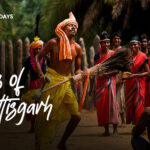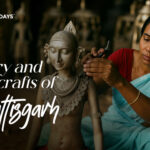Woven Air & Stones of Valor: An Exclusive 3-Day Journey into the Heart of Chanderi Silk
In the heart of India, where the rugged Malwa plateau meets the rolling plains of Bundelkhand, lies a town of paradoxes. To the historian, it is a fortress of blood and gunpowder; to the fashion connoisseur, it is the birthplace of a fabric so sheer it was once likened to “morning dew.” Welcome to Chanderi.
As a traveler who has walked the length of India promoting our dying arts, I can tell you that Chanderi is not just a destination; it is a pilgrimage for anyone who values the loom over the machine. Which state is famous for Chanderi silk?. It is the pride of Madhya Pradesh, a gem hidden 215 km from Gwalior.
If you are planning a trip to discover the origins of this royal fabric, here is your definitive 2N/3D itinerary. This guide will navigate you through the “Gateway of Bundelkhand,” teach you how to identify pure Chanderi silk and ensure you leave with a piece of history in your suitcase..
Day 1: Arrival and The Architecture of Defense
Arrival Logic: Take a train to Lalitpur Junction (the nearest railhead, approx. 40 km away) and hire a taxi. This saves the fatigue of the 5-hour drive from Gwalior.
Afternoon: Entering Through History
As your taxi winds towards the town, your first encounter isn’t with silk, but with stone. You enter through the Katti Ghati a dramatic gateway hewn entirely out of a solid rock hill.
Local legend whispers that this gate was cut overnight by masons for a Sultan who needed to march his army through. In their haste, they forgot to carve hinges for a gate, leading the master mason to commit suicide in shame. Whether myth or fact, passing through this unhinged archway feels like stepping back into 1528 AD
1. Evening: The Sentinel on the Hill
Check into your accommodation—if you are visiting between November and February, I highly recommend the “Tent City” set up for the Chanderi Festival 2025. This initiative by MP Tourism has introduced “Glamping” to Chanderi, solving the town’s lack of luxury hotels
Head immediately to Kirti Durg (Chanderi Fort) to catch the sunset. Perched 71 meters above the town, the fort offers a panoramic view of the weaving clusters below. Walk through the Khooni Darwaza (Gate of Blood) Its ominous name is a reminder of the criminals and enemy commanders whose bodies were once displayed here as a warning.
The Twilight Tribute: Jauhar Smarak
Before descending, pay your respects at the Jauhar Smarak In January 1528, facing defeat against Emperor Babur’s artillery, hundreds of Rajput women committed here. It is a somber reminder that the beautiful silk you will buy tomorrow was protected by men and women who chose death over dishonor.
Day 2: The Weaver’s World – Unveiling the “Woven Air
Today is dedicated to the soft power of Chanderi. We move from the fort to the loom.
Morning: The Rhythm of the Shuttle at Pranpur
Travel 4 km to the Pranpur Craft Village. This is the beating heart of the Chanderi textile tradition. Here, the “thunder of artillery has been replaced by the rhythmic clatter of the shuttle”.
Watching a weaver at work is mesmerizing. You will see them handling the tana (warp) and bana (weft) with surgical precision. This is where you begin to understand the Chanderi silk fabric. Historically, this fabric was known as and was so fine that a length of it could be contained within a hollow bamboo shoot, yet cover an elephant when unfurled.
What is special about Chanderi?
As you watch the weavers, you’ll notice the fabric has a unique transparency. This isn’t accidental.
The Science of Sheer: Unlike other silks (like Kanchipuram) where the yarn is boiled (degummed) to make it fluffy, Chanderi warp silk is often used un-degummed.
The Result: The natural gum (sericin) keeps the thread thin and stiff. When woven with fine cotton, it creates a sieve-like structure that allows light and air to pass through—the scientific secret behind its “woven air” reputation.
Mid-Day Masterclass: How to identify pure Chanderi silk?
You are now ready to shop. But the market is flooded with power-loom imitations from Surat. Standing in a weaver’s cooperative, I asked a master artisan, “How do I know this is real?Here is the checklist for the Identification of a Pure Silk Saree from Chanderi:
1. The Burn Test (The Gold Standard): Ask for a snippet of the thread.
Authentic: It will burn with the smell of burning hair (silk) or paper (cotton) and leave a crushable ash.
Fake : It will melt, smell of chemicals/plastic, and leave a hard bead.
2.The Tactile Test: Run your hand over the fabric. Authentic handloom Chanderi has a slightly uneven texture due to hand-spinning. It creates a soft, muffled sound. Imitations are slippery, shiny, and make a sharp, papery noise.
3. The Reverse Side: Look at the (motifs). In a handwoven saree, the Zari threads at the back are woven in or float securely. in power-looms, they often look mechanically sheared or “cut,” which can irritate the skin.
Shopping Guide: Varieties and Prices
When browsing, you will encounter three main types. Use this guide to determine if the Chanderi Silk sarees price you are quoted is fair:
1. Silk Cotton (The Classic): This is the most popular variety. It uses a silk warp (glossy) and a cotton weft (matte). It is breathable and perfect for Indian summers.
2. Pure Silk (Chanderi Silk): Made of 20/22 denier silk in both warp and weft. These are lustrous, drape fluidly, and are reserved for weddings or evening wear.
3. Chanderi Cotton: Extremely lightweight (300s count historically), matte finish, and fragile. Best for extreme heat.
Why is Chanderi silk expensive?
You aren’t paying for cloth; you are paying for time. A heavy-border Chanderi Silk Saree with Zari border using the Jala technique (manual harness) or complex Jacquard patterns can take weeks to weave20. The use of pure gold or silver Zari also drives up the cost.
Afternoon: Hunting for Motifs
Look for the Ashrafi Buti (Gold Coin motif), which symbolizes wealth and was a favorite of royal courts. If you want something truly rare, ask for the motif. Derived from stone carvings in the fort, its curves are so difficult to weave that few artisans today attempt it, making it a collector’s item.
Day 3: Mysticism, Anomalies, and Departure
Morning: The Mystery of Koshak Mahal
Before your train departs, visit the Koshak Mahal in Fatehabad. Commissioned in 1445 AD, this building is an architectural anomaly. It follows a strict “Cross Plan” with four mansions arranged around a courtyard23.
History says it was meant to be seven stories high, but only three remain24. Walking through its intersecting passages, you feel a natural wind-tunnel effect—a medieval air-conditioning system that mirrors the breathability of the local textiles25.
Late Morning: A Convergence of Faiths
Chanderi is a testament to religious syncretism.
Sikh Heritage: Visit the local Gurudwaras commemorating Guru Nanak Dev Ji’s visit during his second Udasi
Jain Heritage: Stop by the Khandargiri Jain Caves to see the colossal statues of Tirthankaras carved into the hillside, financed by the wealthy Jain merchants who historically bankrolled the silk trade.
Departure: The Final Souvenir
As you pack your bags, ensure your saree has the GI (Geographical Indication) Tag or the Handloom Mark.
Is Chanderi silk washable?
This is a common question. Given the sheer nature of the weave and the use of Zari, do not wash your heritage Chanderi at home. Dry cleaning is the only way to preserve the “woven air” structure and prevent the Zari from tarnishing.
Quick Travel Facts for the 2025 Traveler
Best Time to Visit: October to March (The Golden Window). Avoid summer, as temperatures hit 45°C.
Key Event:Chanderi Festival 2025. Running from November 28, 2025, through February, this festival features adventure sports, craft workshops, and luxury tent stays.
Is Chanderi silk real silk? Yes, but the most famous variety is a Silk-Cotton hybrid introduced by the Scindia royal family around 1910 using Japanese silk.
Chanderi teaches us that beauty and strength are not opposites. The same town that built the impregnable Katti Ghati also wove the fragile400;”>Nalferma. As you leave, you take with you not just a Chanderi Silk Suit or Saree, but a story of resilience—thread by thread, stone by stone.
People Also Ask (FAQ)
Q: Why is Chanderi silk expensive?
A: Authentic Chanderi is expensive due to the high cost of raw materials (mulberry silk and gold Zari) and the labor-intensive handloom process. A single saree can take weeks to complete depending on the intricacy of the Butis (motifs).
Q: Which state is famous for Chanderi silk?
A: Madhya Pradesh. The town of Chanderi is located in the Ashok Nagar district.
Q: Pure Chanderi Silk sarees price range?
A: Prices vary wildly based on the weave. A simple cotton-silk blend might start at ₹4,000, while a bridal Pure Silk Chanderi with heavy Zari work can range from ₹15,000 to ₹50,000 or more.
Q: How to identify fake silk?
A: Use the Burn Test. Real silk burns with the smell of hair and leaves ash. Synthetic silk melts





